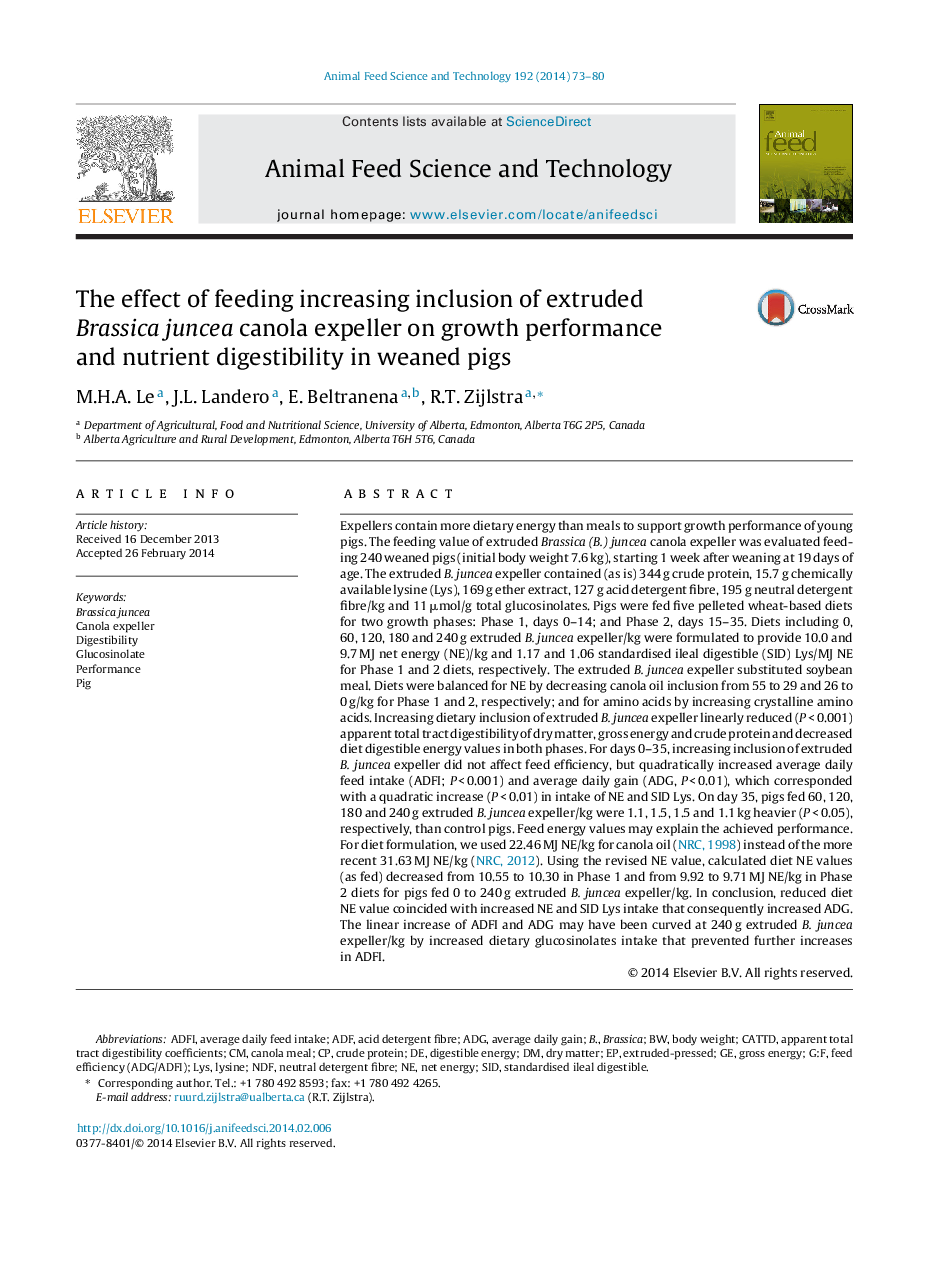| کد مقاله | کد نشریه | سال انتشار | مقاله انگلیسی | نسخه تمام متن |
|---|---|---|---|---|
| 2419619 | 1552393 | 2014 | 8 صفحه PDF | دانلود رایگان |
Expellers contain more dietary energy than meals to support growth performance of young pigs. The feeding value of extruded Brassica (B.) juncea canola expeller was evaluated feeding 240 weaned pigs (initial body weight 7.6 kg), starting 1 week after weaning at 19 days of age. The extruded B. juncea expeller contained (as is) 344 g crude protein, 15.7 g chemically available lysine (Lys), 169 g ether extract, 127 g acid detergent fibre, 195 g neutral detergent fibre/kg and 11 μmol/g total glucosinolates. Pigs were fed five pelleted wheat-based diets for two growth phases: Phase 1, days 0–14; and Phase 2, days 15–35. Diets including 0, 60, 120, 180 and 240 g extruded B. juncea expeller/kg were formulated to provide 10.0 and 9.7 MJ net energy (NE)/kg and 1.17 and 1.06 standardised ileal digestible (SID) Lys/MJ NE for Phase 1 and 2 diets, respectively. The extruded B. juncea expeller substituted soybean meal. Diets were balanced for NE by decreasing canola oil inclusion from 55 to 29 and 26 to 0 g/kg for Phase 1 and 2, respectively; and for amino acids by increasing crystalline amino acids. Increasing dietary inclusion of extruded B. juncea expeller linearly reduced (P < 0.001) apparent total tract digestibility of dry matter, gross energy and crude protein and decreased diet digestible energy values in both phases. For days 0–35, increasing inclusion of extruded B. juncea expeller did not affect feed efficiency, but quadratically increased average daily feed intake (ADFI; P < 0.001) and average daily gain (ADG, P < 0.01), which corresponded with a quadratic increase (P < 0.01) in intake of NE and SID Lys. On day 35, pigs fed 60, 120, 180 and 240 g extruded B. juncea expeller/kg were 1.1, 1.5, 1.5 and 1.1 kg heavier (P < 0.05), respectively, than control pigs. Feed energy values may explain the achieved performance. For diet formulation, we used 22.46 MJ NE/kg for canola oil (NRC, 1998) instead of the more recent 31.63 MJ NE/kg (NRC, 2012). Using the revised NE value, calculated diet NE values (as fed) decreased from 10.55 to 10.30 in Phase 1 and from 9.92 to 9.71 MJ NE/kg in Phase 2 diets for pigs fed 0 to 240 g extruded B. juncea expeller/kg. In conclusion, reduced diet NE value coincided with increased NE and SID Lys intake that consequently increased ADG. The linear increase of ADFI and ADG may have been curved at 240 g extruded B. juncea expeller/kg by increased dietary glucosinolates intake that prevented further increases in ADFI.
Journal: Animal Feed Science and Technology - Volume 192, June 2014, Pages 73–80
